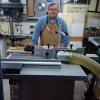I am building a crosscut sled for my TS and have 2 questions:
1) What is a good width to accommodate? I am thinking it should at least allow material 24" wide to fit in it.
2) Some plans use a single miter slot and some use both miter slots. Any advantages to one over the other? It would be easier to use only one because you don't need to align two, but I'm thinking using both slots would be more stable.
Steve




 Reply With Quote
Reply With Quote



 ). 95% or more of my crosscuts are done with the small sled.
). 95% or more of my crosscuts are done with the small sled.
